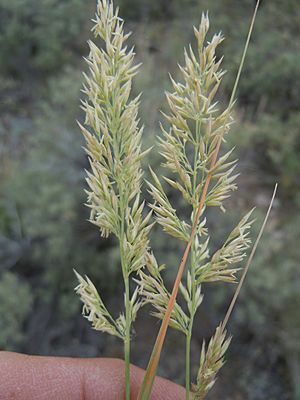Plains reedgrass facts for kids
Quick facts for kids Plains reedgrass |
|
|---|---|
 |
|
| Conservation status | |
| Scientific classification | |
| Genus: |
Calamagrostis
|
| Species: |
montanensis
|
Calamagrostis montanensis is a type of grass often called plains reedgrass or prairie reedgrass. This plant grows naturally in North America. You can find it across Canada, from British Columbia all the way to Manitoba. It also grows south into the United States, reaching as far as Colorado.
This special grass is a perennial plant, which means it lives for more than two years. It grows as a single stem and doesn't form big clumps. It can reach up to 60 centimeters (about 2 feet) tall.
Contents
How Plains Reedgrass Grows
Plains reedgrass has a network of thin underground stems called rhizomes and strong roots. These roots and rhizomes help hold the soil together, forming a thick mat known as sod. Scientists have seen its roots grow over a meter (more than 3 feet) deep into the ground!
The leaves of this grass are stiff and rolled. Most of them grow around the bottom of the stem. They can be up to 15 centimeters (about 6 inches) long, but they are only a few millimeters wide.
Reproduction and Life Cycle
The plant's flowers grow in a narrow cluster called an inflorescence, which can be up to 10 centimeters (about 4 inches) long. Each small flower part, called a spikelet, holds one flower.
Plains reedgrass can make new plants in two ways:
- Vegetative reproduction: It sprouts new plants from its underground rhizomes. This is like a clone of the parent plant.
- Sexual reproduction: It also produces seeds. These seeds are spread by the wind, helping the grass grow in new places.
Where Plains Reedgrass Lives
This grass can be found in many different natural areas. These include cool temperate coniferous forests, areas with sagebrush, dry shrubsteppes, and various types of prairie and grassland.
It is a very important grass in some parts of the Great Basin and Great Plains regions, where it is one of the most common types of grass. Plains reedgrass is tough! It can handle very cold winters and very hot summers. It also grows well in places where the land has been disturbed, like after a fire or construction.
This grass can grow at all stages of how an ecosystem changes over time, which is called ecological succession. In some areas, like the Canadian mixed-grass prairie and the mountains of Montana, it is a "climax species." This means it's a stable and important part of the plant community there.
Plains Reedgrass and Animals
Plains reedgrass is the only type of Calamagrostis grass that provides forage (food) for grazing animals on the northern Great Plains. Animals like cattle and horses eat it. Sheep eat it less often. It's not their favorite food because its leaves are a bit rough to chew.
See also
 In Spanish: Calamagrostis montanensis para niños
In Spanish: Calamagrostis montanensis para niños


